My Phlox is blooming..

You are using an out of date browser. It may not display this or other websites correctly.
You should upgrade or use an alternative browser.
You should upgrade or use an alternative browser.
Live Stoner Chat Live Stoner Chat - Jul-Sep '22
- Thread starter 420Forever
- Start date
- Status
- Not open for further replies.
- Joined
- Sep 1, 2014
- Messages
- 13,103
- Reputation
- 5,466
- Reaction score
- 46,567
- Points
- 0
- Currently Smoking
- yo arse
Some one told you some nonsense!Pretty sure someone smarter then me told me LED won’t burn/stress plant from intensity it’s only the heat from the diodes that can cause issues!
LED are very capable of causing light stress, I can vouch for that from personally experience.
I have had bleached bud tips and not from any heat.
Throw too many photons at to high an intensity, you will harm your plants.
Light stress shows slightly differently from heat stress.
Light Stress the leaf serrations turn up and look like a crocodile/dragon teeth, the actual leaf blade remains uncurled!!
Heat stress the whole leaf folds along it's length otherwise known as taco-ing!
Cannabis likes between 25W and 50W per foot square anything over 50W per foot square, is wasted light and energy and can actually harm your plants, rather than help them grow.
- Joined
- Sep 1, 2014
- Messages
- 13,103
- Reputation
- 5,466
- Reaction score
- 46,567
- Points
- 0
- Currently Smoking
- yo arse
9 days since they were planted out in my bramble fort guerilla grow!
I was surprised they hadn't withered in the heat but they wear actually on fine form.
Green, healthy and with a surprising amount of new growth!
I shared 15 liters of water between them and I hope to visit a bit sooner next time!
We have drought conditions here in the UK, with hose pipe bans everywhere!
These ladies need their drink, to grow big and strong, so looks like there is a fair bit of water hauling, for me in the near future.
In the mean time I will keep praying for rain!
- Joined
- Sep 15, 2016
- Messages
- 28,019
- Reputation
- 22,801
- Reaction score
- 116,222
- Points
- 0
- Currently Smoking
- Dabs of Rosin.
I know the stories but my personal experience is I cannot burn plants with my ChilLed GrowCraft 500s only leaves that actually touched the diodes burned. This was in my Summer 2020 Photoperiod grow. Even with super cropping they grew past the lights. There were no signs of burn on these or any other plant I have grown under LED only.Some one told you some nonsense!
LED are very capable of causing light stress, I can vouch for that from personally experience.
I have had bleached bud tips and not from any heat.
Throw too many photons at to high an intensity, you will harm your plants.
Light stress shows slightly differently from heat stress.
Light Stress the leaf serrations turn up and look like a crocodile/dragon teeth, the actual leaf blade remains uncurled!!
Heat stress the whole leaf folds along it's length otherwise known as taco-ing!
Cannabis likes between 25W and 50W per foot square anything over 50W per foot square, is wasted light and energy and can actually harm your plants, rather than help them grow.
DankDoctor420
Cultivators Club
- Joined
- Oct 20, 2021
- Messages
- 668
- Reputation
- 230
- Reaction score
- 2,610
- Points
- 0
- Currently Smoking
- Cheese Quake
Very good video about plants being able to take carbon in through the soil instead of pulling CO2 through the air. I never knew this til now but loved the video so wanted to share some knowledge. Check it out here if you'd like
No more pics cuz of my phone but i cut down the 2 plants i should have pulled a long time ago. I decided I was sick of their bullshit and they're hanging up now so naturally:
Very good video about plants being able to take carbon in through the soil instead of pulling CO2 through the air. I never knew this til now but loved the video so wanted to share some knowledge. Check it out here if you'd like
I watch this dude all the time
- Joined
- Mar 6, 2021
- Messages
- 4,964
- Reputation
- 4,171
- Reaction score
- 21,605
- Points
- 0
- Currently Smoking
- Double Bubble, Bubble Tricks
They seem to do grow great outside with 2000par blasting away
- Joined
- Sep 1, 2014
- Messages
- 13,103
- Reputation
- 5,466
- Reaction score
- 46,567
- Points
- 0
- Currently Smoking
- yo arse
I did not say I burned the leaves, I said that heat stress with Led is a very real thing, which it is.I know the stories but my personal experience is I cannot burn plants with my ChilLed GrowCraft 500s only leaves that actually touched the diodes burned. This was in my Summer 2020 Photoperiod grow. Even with super cropping they grew past the lights. There were no signs of burn on these or any other plant I have grown under LED only.
I also mentioned the difference between light stress and heat stress.
When I noticed the light stress, it was because I had too many watts of lights/power in my cab, the intensity was over the top.
I think you should have quoted @Fermented_Fruitz original comment rather than my reply!
I copied this from grow weed easy
Light Burn or Light Stress

Problem: Your cannabis plant can only withstand a certain amount of light. After a certain point, your cannabis will start turning yellow or otherwise exhibit signs of stress on the leaves near the sources of light and/or heat.
How far away do I keep grow lights from my plants?
Light burn usually causes yellow leaves at the top of the plant directly under the grow lights (though it can appear on older leaves that have been exposed for a long time).
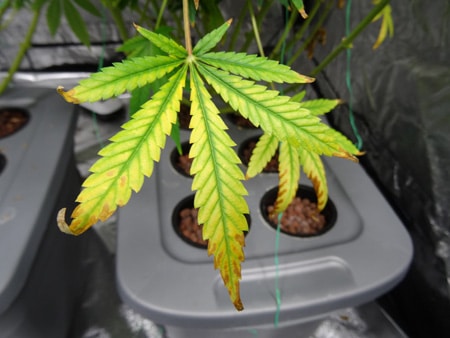
Sometimes the first sign a plant is getting too much light is all the leaves start pointing up or “praying”, like this (though sometimes you don’t see any symptoms until the yellowing starts)
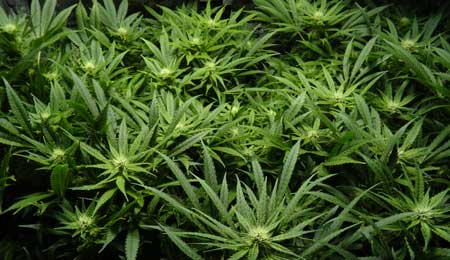
With light burn, often the inside veins stay green. Yellow leaves won’t fall off or be plucked off easily, unlike a nitrogen deficiency where leaves fall off on their own.
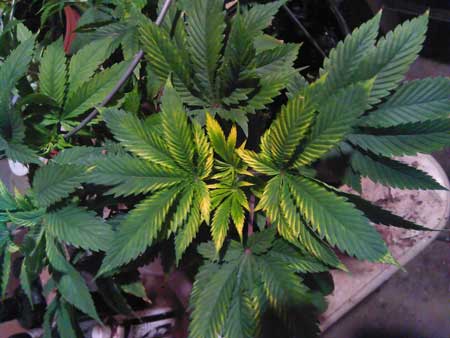
The leaves closest to the light may appear much more pale than the rest of the plant, and tips may turn yellow.
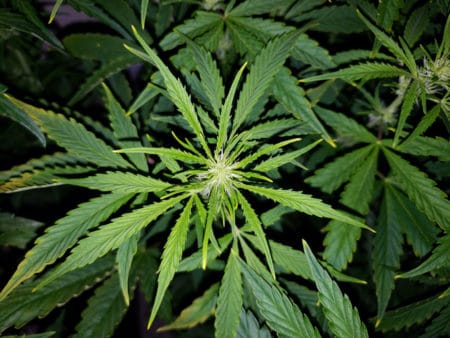 Another example of yellow tips from light burn
Another example of yellow tips from light burn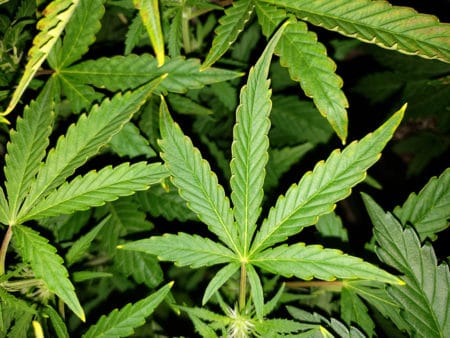
Sometimes light burn causes edges of leaves to turn up. If it goes on a long time, the leaves also start to become crispy and can even break off if you try to bend them
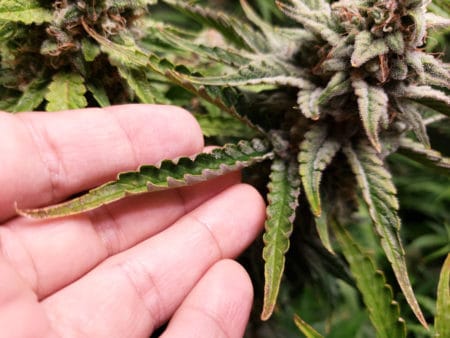
You may noticed just the tallest colas getting droopy, which is sometimes a sign the light is too intense (though it could also be caused by root problems or over/under watering)
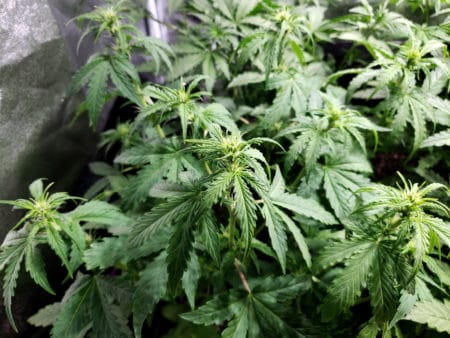
Light burn is often mistaken for a Nitrogen deficiency which makes wilting yellow leaves. Nitrogen-deficient leaves fall off on their own, while light-burned leaves are hard to pluck off. A nitrogen deficiency starts from the bottom of the plant and moves up, while light burn often is worse at the top of the plant.
Cannabis light burn usually affects the top leaves closest to the grow light
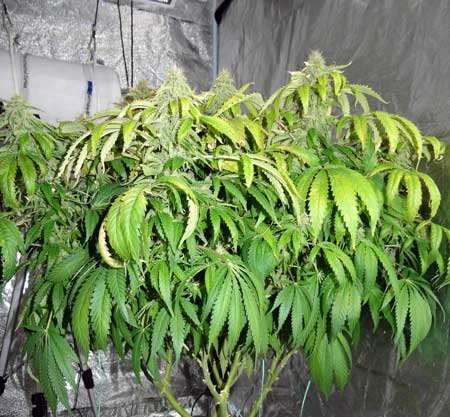
A Nitrogen deficiency creates yellow leaves at the bottom of the plant as the Nitrogen is sucked out of the oldest leaves to feed the top of the plant. On the other hand, light burn produces yellow leaves at the top of the plant under the grow lights because the leaves have worked too hard and/or too long from the light being too close. The leaves aren’t able to keep up with regular plant processes.
Imagine sitting outside all day under a scorching sun, possibly for days on end. Even if you could handle it for a day or two, it might wear you down over days or weeks.
How can there be too much light if there’s no heat? Read the full guide
It’s probably light burn if mostly just the leaves closest to the lights are turning yellow
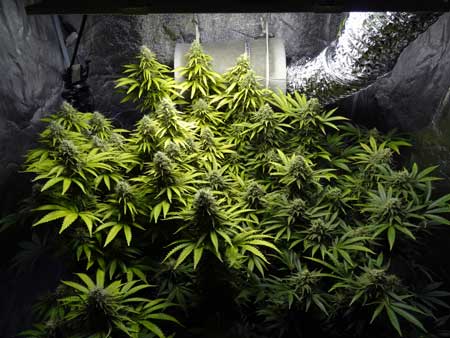
With cannabis plants that have light burn, your leaves can sometimes become yellow or red/purple, possibly with brown spotting, often with burnt tips/edges and margins that stay green. Other problems, like nutrient problems, can trigger or make the symptoms of light burn a lot worse. Leaves may also appear generally burnt in places when there’s too much light, especially when combined with heat or nutrient problems.
Nutrient deficiencies make light burn worse!
If you see light bleaching and unhealthy discoloration only on the parts of the plant directly under your grow light, or only on older leaves that are exposed to the light, it often means it’s too bright for your plants and you should move your grow lights further away! If your plant is also having other problems, it is much more likely to be affected by light burn. A healthy plant can withstand higher light levels than a sick plant.
If the lights are only slightly too close, maybe just an inch or a few cm, the yellowing from light burn may happen slowly over the course of days (or even weeks!) because leaves are dying early instead of immediately. Because of that, light burn may first appear on somewhat older leaves, which can be confusing and make it hard to diagnose.
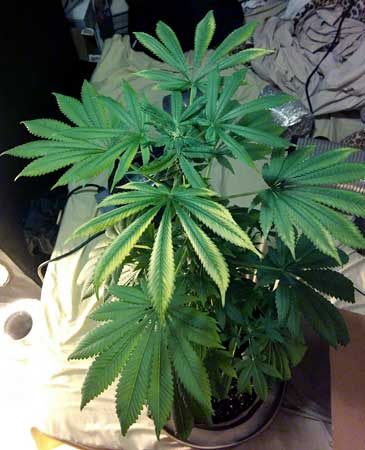
This cannabis seedling is being burned by too-close LED grow lights
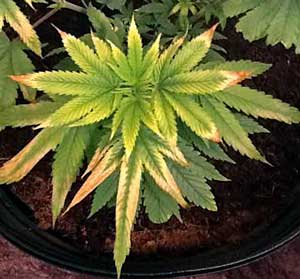
Another example of light burn from an LED grow light being kept too close to the plants
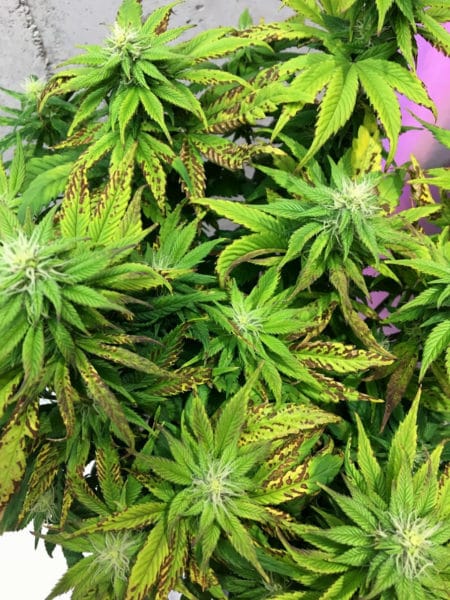
These leaves of this LED-burnt plant started curling upwards
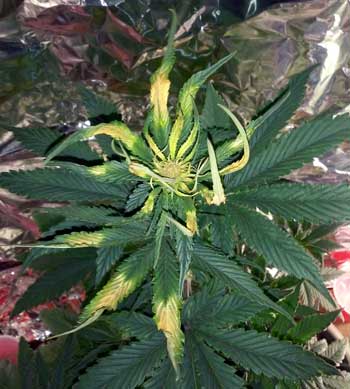
This cannabis seedling basically grew up into the grow light! The heat from the bulb caused massive burning everywhere it touched. If a plant’s leaves directly touches the lights, it leaves “burns” from the heat of the bulbs.
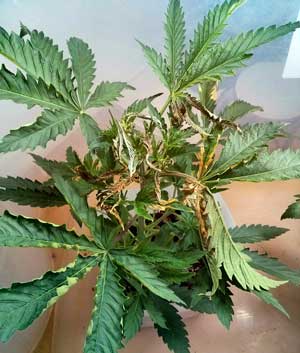
This plant was green and healthy through the vegetative stage under an LED grow light, but the leaves started dying soon after flowering started (even though that distance had been fine in the vegetative stage). The reason was the LED was too close. This is also very common with LED grow lights with just read and blue diodes, without any diodes in the green spectrum.
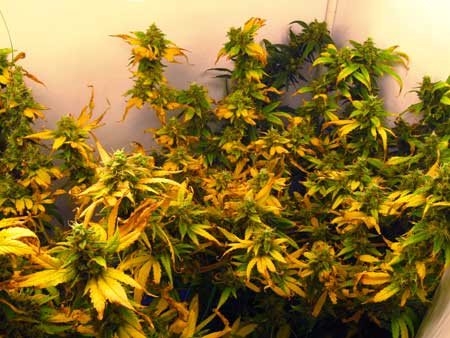
These plants seem apparently healthy, but the top leaves keep getting lighter and lighter, in this case from a 600W HPS that was kept just under a foot (30cm) away. The leaves slowly turned yellow over the course of a few weeks, getting light burn even though the temperature was a comfortable 75°F (24°C).
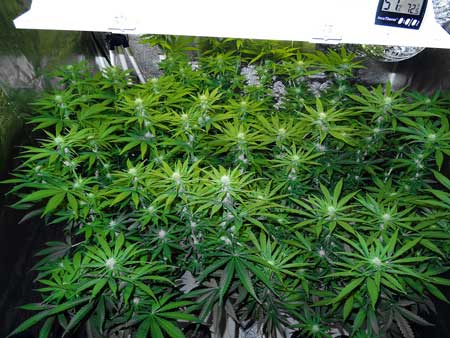
These yellow leaves were caused by an LED grow light that was too close. If you don’t realize it’s light burn, the symptoms are inexplicable!
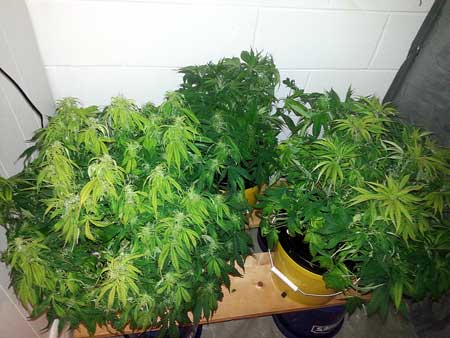
A mild case of marijuana light burn is often mistaken for a nutrient deficiency or a pH problem, but if you look closely, the symptoms are concentrated directly under the grow light.
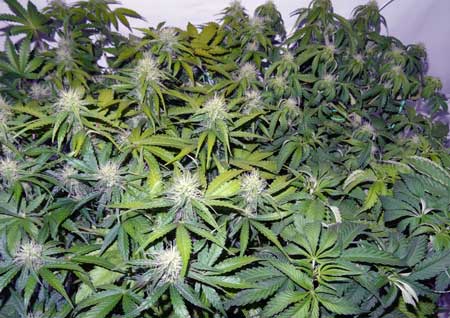
Light Bleached Cannabis Buds Sometimes Turn White
This is how you get “albino” or white buds. Light bleaching is most common with high-power LEDs and HPS grow lights because these can be brighter than the sun. Basically, bud bleaching is what happens when buds get too much light, kinda like how hair can get bleached if you spend plenty of time in the sun. Except a “sun-burnt” bud is often less potent, and may have lost it’s “cannabis” smell!
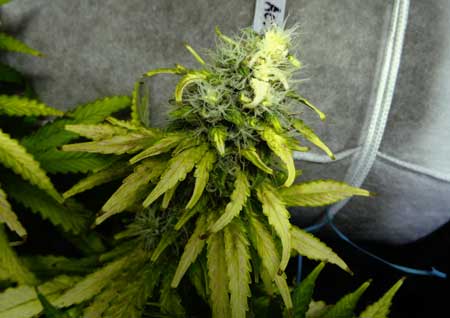
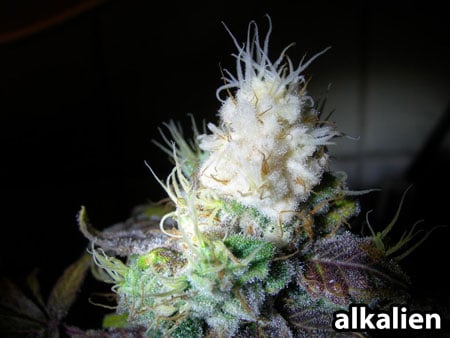
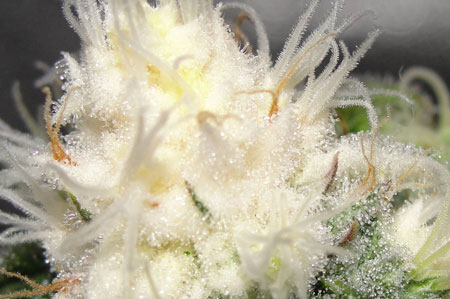
Buds which have been bleached tend to be low potency or even have no potency (no available THC or other cannabinoids). Therefore you should avoid light-bleaching your plants at all costs!
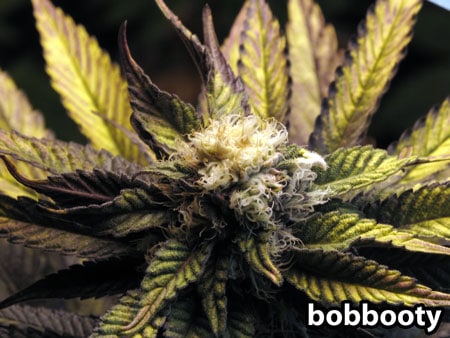
Sometimes light-bleached cannabis will get mis-labeled as “albino cannabis” or “white cannabis” but the truth is that the white color is not healthy, so this is not a desirable trait (even if it looks pretty cool).
Most of the Time, Light-Burned Buds Appear Burnt
Often though, light burned buds look like they’ve been burned.
LED-burnt cannabis buds – notice how all the tiny “sugar leaves” have turned yellow or brown
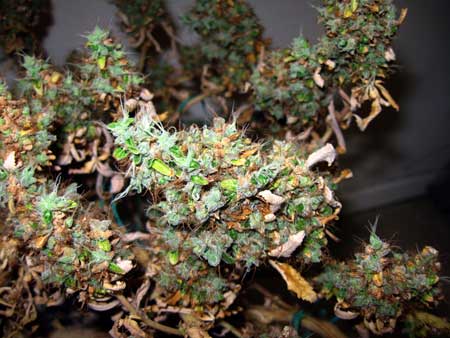
In this case the LED-burn caused the leaves closest to the LED to turn red. Although the buds smoked pretty well anyway, they definitely weren’t as pretty as they could have been!
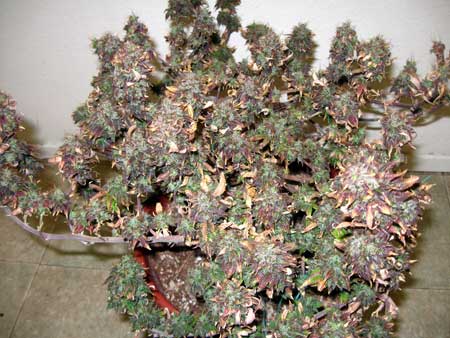
The leaves too close to the LED grow light turned yellow and wilted. For some reason, cannabis plants seem a lot more prone to light burn after they start flowering.
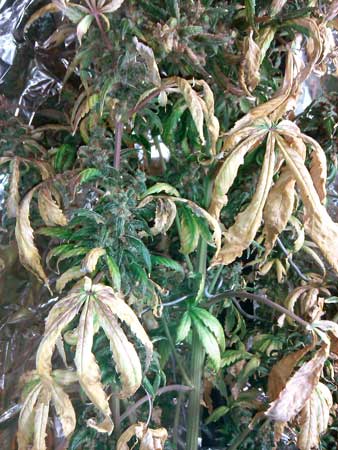
Another example of a bud that has light burn from a too-close LED
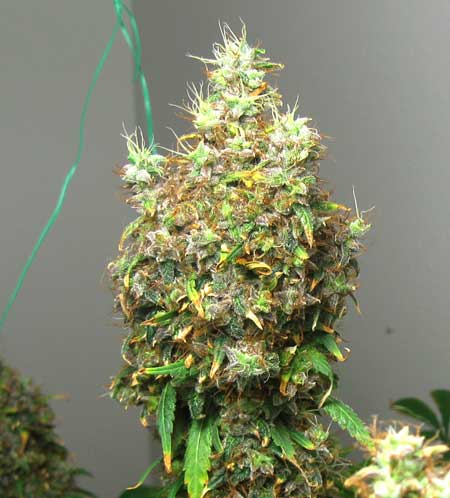
Light burned bud on top, healthy bud below
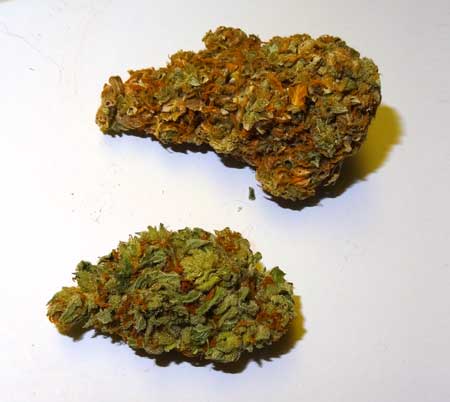
Solution: If your marijuana plants are getting too much light, try removing some of the lights or moving your grow lights further away from the tops of the plants. If you can’t move the light further away, bend your plants over so the tops are further away or if your plant is still in the vegetative stage you might even consider cutting off the top of the plant to remove some of that height.
Reduce power of grow lights and/or move them further away from your plant
(How far away do I keep grow lights from my plants?)
It is unlikely for your plants to get “light-burned” from the sun when growing outdoors, and they definitely can’t accidentally grow into the sun. Outdoor plants can show signs of light stress if plants were used to shady conditions and moved into direct sunlight without time to get accustomed to the brigher light levels. It also may be possible in extreme high light conditions if the plant is unprotected but in general cannabis plants like a lot of light.
When making changes to your plant’s environment, it’s best to make changes relatively slowly if possible. For example when moving a cannabis plant from indoors or outdoors you might consider giving the plant some shade for a few days before moving it into full sunlight.
Sometimes heat stress can look like light stress. When learning how to grow cannabis, it’s best to try to keep things at a comfortable temperature at all times for optimal growth. If it’s too hot for you, it’s probably too hot for your plants. Outdoors, it’s a lot harder to control temperature, but there are steps you can take to protect your outdoor plants from the heat including supplementing with sea kelp, partially covering them and making sure they’re well watered.
- Status
- Not open for further replies.
Similar threads
- Replies
- 12K
- Views
- 279K
- Replies
- 18K
- Views
- 487K
- Replies
- 19K
- Views
- 573K
- Replies
- 16K
- Views
- 715K
- Replies
- 15K
- Views
- 607K
